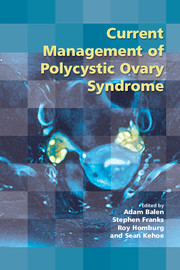Book contents
- Frontmatter
- Contents
- Participants
- Declarations of personal interest
- Preface
- 1 Overview and definitions of polycystic ovary syndrome and the polycystic ovary
- 2 Genetics and pathogenesis of polycystic ovary syndrome
- 3 Ethnic variations in the expression of polycystic ovary syndrome
- 4 Quality of life for women with polycystic ovary syndrome
- 5 Insulin resistance, the metabolic syndrome and polycystic ovary syndrome
- 6 Management of polycystic ovary syndrome through puberty and adolescence
- 7 Long-term health risks of polycystic ovary syndrome
- 8 Approaches to lifestyle management in polycystic ovary syndrome
- 9 Management of obesity in polycystic ovary syndrome, including anti-obesity drugs and bariatric surgery
- 10 Definition of hyperandrogenism
- 11 Treatment of hyperandrogenism in polycystic ovary syndrome
- 12 Choices in the treatment of anovulatory polycystic ovary syndrome
- 13 Predictors of ovarian response to ovarian stimulation: progress towards individualised treatment in ovulation induction
- 14 Surgical management of anovulatory infertility in polycystic ovary syndrome
- 15 The role of insulin-sensitising drugs in the treatment of polycystic ovary syndrome
- 16 The role of in vitro maturation of oocytes for anovulatory polycystic ovary syndrome
- 17 Acupuncture and/or herbal therapy as an alternative or complement for relief of polycystic ovary syndrome-related symptoms
- 18 Consensus views arising from the 59th Study Group: Current Management of Polycystic Ovary Syndrome
- Index
13 - Predictors of ovarian response to ovarian stimulation: progress towards individualised treatment in ovulation induction
Published online by Cambridge University Press: 05 July 2014
- Frontmatter
- Contents
- Participants
- Declarations of personal interest
- Preface
- 1 Overview and definitions of polycystic ovary syndrome and the polycystic ovary
- 2 Genetics and pathogenesis of polycystic ovary syndrome
- 3 Ethnic variations in the expression of polycystic ovary syndrome
- 4 Quality of life for women with polycystic ovary syndrome
- 5 Insulin resistance, the metabolic syndrome and polycystic ovary syndrome
- 6 Management of polycystic ovary syndrome through puberty and adolescence
- 7 Long-term health risks of polycystic ovary syndrome
- 8 Approaches to lifestyle management in polycystic ovary syndrome
- 9 Management of obesity in polycystic ovary syndrome, including anti-obesity drugs and bariatric surgery
- 10 Definition of hyperandrogenism
- 11 Treatment of hyperandrogenism in polycystic ovary syndrome
- 12 Choices in the treatment of anovulatory polycystic ovary syndrome
- 13 Predictors of ovarian response to ovarian stimulation: progress towards individualised treatment in ovulation induction
- 14 Surgical management of anovulatory infertility in polycystic ovary syndrome
- 15 The role of insulin-sensitising drugs in the treatment of polycystic ovary syndrome
- 16 The role of in vitro maturation of oocytes for anovulatory polycystic ovary syndrome
- 17 Acupuncture and/or herbal therapy as an alternative or complement for relief of polycystic ovary syndrome-related symptoms
- 18 Consensus views arising from the 59th Study Group: Current Management of Polycystic Ovary Syndrome
- Index
Summary
Introduction
Ovarian response can be defined as the endocrine and follicular reaction of the ovaries to a stimulus. The term is used in clinical research and practice both qualitatively (for example, achieving growth of a single dominant follicle and ovulation in anovulatory women undergoing ovulation induction) and quantitatively (for example, the extent of multifollicular development in ovulating women undergoing ovarian stimulation for in vitro fertilisation). Achieving a distinct ovarian response usually represents the desired outcome of pharmacological interventions on the hypothalamic–pituitary–ovarian axis in ovulation induction and ovarian stimulation. The considerable individual variability in ovarian response to stimulation, however, necessitates close monitoring and dose adjustment for each woman. The likelihood of pregnancy in a woman undergoing ovulation induction is subject to a large number of factors other than ovarian reserve and ovarian response.
It is of high clinical relevance to identify predictors of ovarian response that will enable clinicians to individualise ovulation induction strategies, thereby minimising complications and the risk of treatment failure while maximising the chances of a continuing pregnancy. The conventional paradigm in many areas of reproductive medicine has been ‘one size fits all’ or a choice of therapy based on the physician's experience from their own clinical practice, which may have low reproducibility. To improve consistency between clinics, various clinical, endocrine and ovarian ultrasonographic and genetic characteristics have been explored for use as predictors of ovarian response.
Keywords
- Type
- Chapter
- Information
- Current Management of Polycystic Ovary Syndrome , pp. 153 - 164Publisher: Cambridge University PressPrint publication year: 2010



